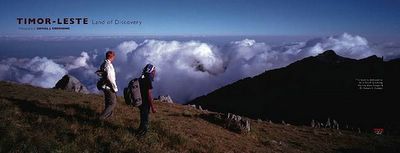
One of the many tiny octopuses found last night. If you are really an octo-freak, like Kate, check out The Octopus News Magazine Online
Most of the photos posted to this page were taken with a Canon 20D in an Ikelike housing with TTL connection to an Ikelite DS-125 and an Inon 2000 substrobe. I also use a Sony Cybershot P150 in a Sony housing attached to a Sea & Sea YS-25 via fiberoptic cable.



More elusive than a Dugong and tougher than an Iraqi insurgency, The Timor-Leste Land of Discovery book has finally gone to press!Books will be available in January. Please visit Dan's web site at http://www.tayophotogroup.com for more info or to order copies.
After more than two years of photography, 700 rolls of film, 15,000 digital photos, 185 underwater dives, 10 months of design and layout, text from two presidents and two Noble Peace Prize winners, 11,300 kilos of paper printing some 1,056,000 book pages, at 10am on the 23rd of December 2005, this exciting moment is finally upon us.
Printed on a brand new state of the art $10 million HK dollar printer and hard bound with a delicate woven cotton (makes a nice pillow), Timor-Leste Land of Discovery promises to be a beautiful 192 page book coffee table book.



